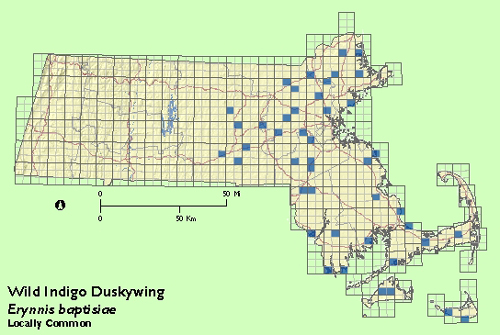Find a Butterfly
Wild Indigo Duskywing
Erynnis baptisiae
Named
Forbes, 1936

Identification
Wingspan: 1 1/8 - 1 5/8". Distinguished from the common larger duskywings (Juvenal‘s and Horace‘s) by smaller size (almost no overlap), by a characteristic pale brown (sometimes slightly orange) area near the leading edge of the forewing above just beyond half way out to the tip, and by less conspicuous translucent spotting at the tip of the forewings. Females are not nearly as mottled as the those of the two larger species. Very similar to Persius and Columbine Duskywings, both now very rare or extirpated in Massachusetts. The best distinctions among these smaller species involve the white hair-like scales that occur on the forewings (above) of fresh males. In Wild Indigo, these hairs are flat and pressed close to the wing surface; in Persius, they are truly hair-like, curved and rise distinctly above the plane of the wing. Habitat and distribution are also useful clues: Columbine is (or was) generally a species of rocky woods in the western part of the state, while Wild Indigo and Persius are species of dry open country and more prevalent in the east. Persius can be separated from the other two by distinctive male genitalia, but Wild Indigo and Columbine are too close to call on this basis. As a rule, any duskywing of this species group in eastern Massachusetts is virtually certain to be Wild Indigo.
Distribution
Widespread throughout most of the United States east of the Great Plains from southern Minnesota and central Texas east to southernmost New Hampshire and northern Florida. In New England, it reaches its northern limit in New Hampshire (and Vermont?).
Status in Massachusetts
Atlas records (nearly all with vouchers) show this species to be rather frequent to locally common in all of the eastern counties, but not recorded by the Atlas, or by Schweitzer in the 1970‘s, from west of Worcester County. Older reports in this group are unreliable due to confusion with other species. Maximum: 80, Foxboro (Norfolk Co.), 15 July 1991.

Flight Period in Massachusetts
Atlas dates run from the first week of May into late August, with peak numbers from mid-July to mid-August, with no clear break between the two broods. Fresh second brood adults can start as early as the last week of June at Middlesex Fells. Normally the species is infrequent until about mid- or late May inland and late May in Plymouth County and Cape Cod. A few stragglers persist into September on Martha‘s Vineyard and a partial third brood occurs into late September some years in Connecticut. Extreme dates: 26 April 1995, Foxboro (Norfolk Co.), B. Cassie, and 29 September 1994, Wellesley (Middlesex Co.), R. Forster.
Larval Food Plants
Wild Indigo (Baptisia tinctoria) (Fabaceae). During the Atlas period (1986-1990), this duskywing still seemed to be associated exclusively with its original regional foodplant in Massachusetts. However Crown Vetch (Coronilla varia)* has become the principal foodplant in many states including Pennsylvania, New York and New Jersey in recent years and this may now be the case in New England. Pavulaan (pers. comm.) notes that in Maryland he found suspected baptisiae ovipositing on garden columbine. The larvae were reared to adulthood and sent to H.A. Freeman, who determined them as this species.
Adult Food sources
Noted on eleven species of wildflowers during the Atlas period, mainly composites and legumes, including the blossoms of its food plant. Like other duskywings, this one often sips from moist earth.

Habitat
Dry, open to brushy, rocky or sandy places such as roadsides and other deliberately disturbed areas, recently burned lands, pine barrens or other places where the foodplant is numerous. At present, powerline corridors are the most common habitat. Due to the changeable nature of the habitat, local extinction of small colonies is common, but so is recolonization. Larger colonies are generally persistent.
Life Cycle
EGG: Presumably pale green turning reddish brown with age; a hemispherical dome with prominent vertical ribs, finer raised lateral lines in between and an overall microsculpture of tiny punctures or points. OVIPOSITION: Eggs are laid singly on the underside of Wild Indigo leaves. LARVA: Presumably yellowish green with a darker green stripe down the back and a pale yellow line down the sides; covered with fine short hairs arising from tiny whitish dots; head black or brown with variable paler markings. The caterpillars make a nest, usually between two or three leaves. Most or all first brood larvae develop directly into the second brood. Second brood larvae hibernate in a leaf roll cocoon in the litter and pupate in the spring. CHRYSALIS: Presumably generally green with some contrasting shade on wings thorax or abdomen. PUPATION: On emerging from hibernation in the early spring the mature larva makes a new leaf roll nest in which to pupate lining it with silk; it eats nothing before pupation. This first pupal period may take longer than that of the two summer broods. OVERWINTERING STAGE: Mature larva.
Notes
Unlike males of persius, males of this species defend territories to which they will usually return when flushed. Typically a territory contains several perches which are projecting twigs or last year‘s dried herbs about two feet above the ground. They also land often on the ground.
Data with voucher specimens of this group of duskywings (especially those from western New England) should note the nature of the habitat and which food plant the butterflies are associated with.
This account was contributed by Dr. Dale Schweitzer, Invertebrate Zoologist, Eastern Heritage Task force/The Nature Conservancy.



